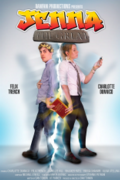It always fascinates me that a genre like zombie films, which is so overcrowded, still regularly provides interesting reimagining of their main premise. From under-the-radar films like
Maggie to TV shows like The Walking Dead that became global phenomena, it looks like we just can’t get enough of these brain-craving monsters. But, even more interestingly, the same genre works quite well in the domain of low-budget filmmaking and Our Final Days Together series provides a perfect example.
Written, directed and shot by
Jonathan Vargas, a young film author from Florida, the series currently includes two parts, both of which follow a girl named Claire, played by Vania Vieta, as she navigates the world of Miami after a terrorist unwantedly triggered a zombie outbreak which quickly destroyed practically everything. In the reality where the undead reign supreme, surviving often comes with a heavy price and series examines the same toll in great detail.
Vargas is now a veteran author in the domain of filmmaking, which is seen through his work - a constant stream of improvements and upgrades is a clear trend. In his previous big project,
Gaby’s Revenge, Vargas took on a neo-noir thriller web series. This time, he clearly wants to explore the areas of zombie horror, but at the same time, cleverly, he also pushes into a drama that is cut with a great chunk of the vintage suspense thrillers.
From the construct of both films, Vargas aims to merge genres into something that is part family drama, part Hickok film, all with a healthy dressing of zombie tropes. The form in which the films are made also serves this purpose - shot in black and white, with practically no props besides a few guns, the films are bleak and bare, just like the world of death and senseless loss in which humanity finds itself in after the collapse. The gist of the films takes place mostly in the dialogues between the characters, in which the notions of old and new collide forcefully. In the old order of things, lives and murders carried a different weight than in the new one.
Now, as the zombies roam the streets and the minds of survivors become polluted and/or diluted with the horrors that the apocalypse brought, there are no good choices or correct answers. In the films, it’s like Vargas tries to say that in this type of event, we all lose, regardless of the fact that we can die right away or kill to live another day. Still, his writing, like in his previous works, manages to end up at the notion of a family and what means to lose it or protect it when the danger is the greatest. The series shows one way or the other, protecting that safe harbor is no longer possible, in spite of the sacrifice some are willing to make to protect their loved ones.
But, while the general sentiment might be pessimistic, the tension of individual films is the strongest suit of the series. From the set up to the framing, everything in these moments underlines the fact that something wicked is approaching the characters. In these pulsating, unnerving segments, Vargas shows he can master the moment with just his shots and some ambient sounds, giving the films a very engaging trait.
At the same time, Vargas steadily builds a greater narrative which will clearly follow Claire into a very uncertain future as well - like always for her, there she can find either death or safety. That is why, at the very end of each episode, the pessimism still gives way to a glimmer of hope, no matter how much doubt and violence comes with it. I can only wait for new episodes and hope Claire will not lose her life or something even more precious - her soul.
Watch the first part
here and the second part premiers in April 2017.




























